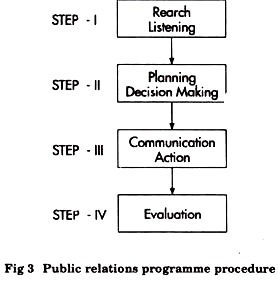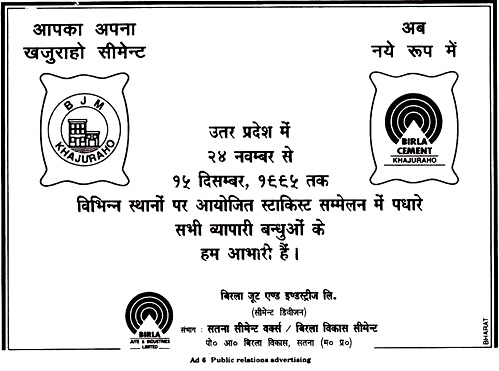This article provides an essay on public relations advertising.
Introduction to Public Relations Advertising:
Public relations involves the use of variety of tools to build good relations between an organisation and individual and certain important sections of the public. Public relations “is a planned effort to influence opinion through socially responsible and acceptable performance based on mutually satisfactory two way communication”.
Public relations involve the following elements:
1. Steps taken to ensure that said policies, procedures and actions are in the public interest and socially responsible.
2. An organisation’s policies, procedures and actions as they relate to said organisation’s publics.
3. Development of rapport, good will, understanding and acceptance as the chief end result sought by public relations activities.
4. A planned effort or management function.
5. Evaluation of public attitudes and opinions.
6. Execution of an action and/or communication programme.
7. The relationship between an organisation and its publics.
The scope of public relations is hard to estimate because of lack of precision in definition. Most people practice public relations as a business work for individual firms, for advertising or public relation agencies, for industry wide organisations or for non-profit organisations such as education and government units.
The individual firms have many public relations problems. Some firms concentrate primarily on defending off attacks from competitors or critics but more and more firms are looking to areas where they can assume a role of social responsibility.
Advertising agencies are sharply divided on whether they should provide public relations help for their clients. The most consumer arrangement is to have a public relations division within the agency. Several agencies, however, have established entirely or partly owned public relations subsidiaries.
A number of agencies maintain working relations with outside public relations firms. Organisations very widely from one agency to another and even from account to account within the agency. Some provide everything from production of client’s house organs to operations of test kitchens and open houses.
Others confines their activities to getting favourable publicity for the client’s product. Some public relations counselors maintain that public relations can best be performed by a firm that denotes its entire time and energy to this one function.
The advertising agency that also offers a public relations service typically argues that the best way to serve a client is to provide a “total communications” service—a mixture of marketing, advertising and public relations. By dealing on a cohesive basis with all of a company’s “relations problems”, it thinks that it can more readily accomplish the company’s corporate goals.
Procedure of an Effective Public Relations Campaign:
In general public relations is for companies that conscientiously try to live up to the modern concept of social as well as economic responsibilities. Unless a public relations programme is backed up by good intentions it has little chance of success. Today, few business policies are set without appraisal of their ultimate effect on the firm’s public relations.
According to Scott Cutlip and Allen Center, there are four basic steps in any successful public relations programme:
Step-I:
Research: Listening:
This involves probing the opinions, attitudes and reactions of persons concerned with the acts and policies of an organisation—the evaluating the inflow. This task also requires determining the facts regarding the organisation.
Step-II:
Planning:
Decision—Making: this involves bringing these attitudes, opinions, ideas, and reactions to bear on the policies and programmes of an organisation. It will enable the organisation to chart a course in the interests of all concerned.
Step-III:
Communication:
Action—This Involves explaining and dramatizing the chosen course to all those who may be affected and whose support is essential.
Step-IV:
Evaluation:
This involves evaluating the results of the programme and the effectiveness of techniques used. These four steps exemplify, that it is a process. Each step is as important as the other, and all of these activities must be done in harmony.
For example, to put a plan into action, via various communication media, without adequate research is to court disaster. The best public relations programmes are those that anticipate difficulty and take into account, in advance, negative public attitudes or feelings.
Public Relations Advertisement:
The public relations advertisement can include almost anything that will help advance a particular objective.
Following fourteen subjects can be included in public relations advertisements:
1. Labour relations including the company’s side in labour disputes.
2. Proxy fights for company control.
3. Community relations—plant openings, plant expansions, plant open houses, company anniversaries, annual statements, promotion of community activities (such as a safety campaign).
4. Product difficulty or public misunderstanding that must be cleared up immediately.
5. Promotion of art contests, essay contests, scholarship awards, and so forth.
6. Recruitment of employees.
7. Consolidation of editorial opinion.
8. Promotion of or opposition to pending legislation.
9. Presentation of industry or professional activities and points of view.
10. Statements of policy.
11. Consolidation of editorial opinion.
12. Celebration of local institutions, such as the press during National Newspaper Week.
13. Records of accomplishment.
14. Supplier relations.
Principles of Public Relations Advertising:
Following guidelines/principles are to be observed for preparing public relations advertising:
1. Use simple, unvarnished words and facts so that every housewife in the community will understand and believe what you have to say.
2. Use figures sparingly—and only when illustrated by simple, every day examples.
3. Tell one story at a time—don’t overload your copy.
4. Tell your story directly to an individual in his own language.
5. Be frank, fair, and honest.
6. Don’t talk up or down to anyone.


